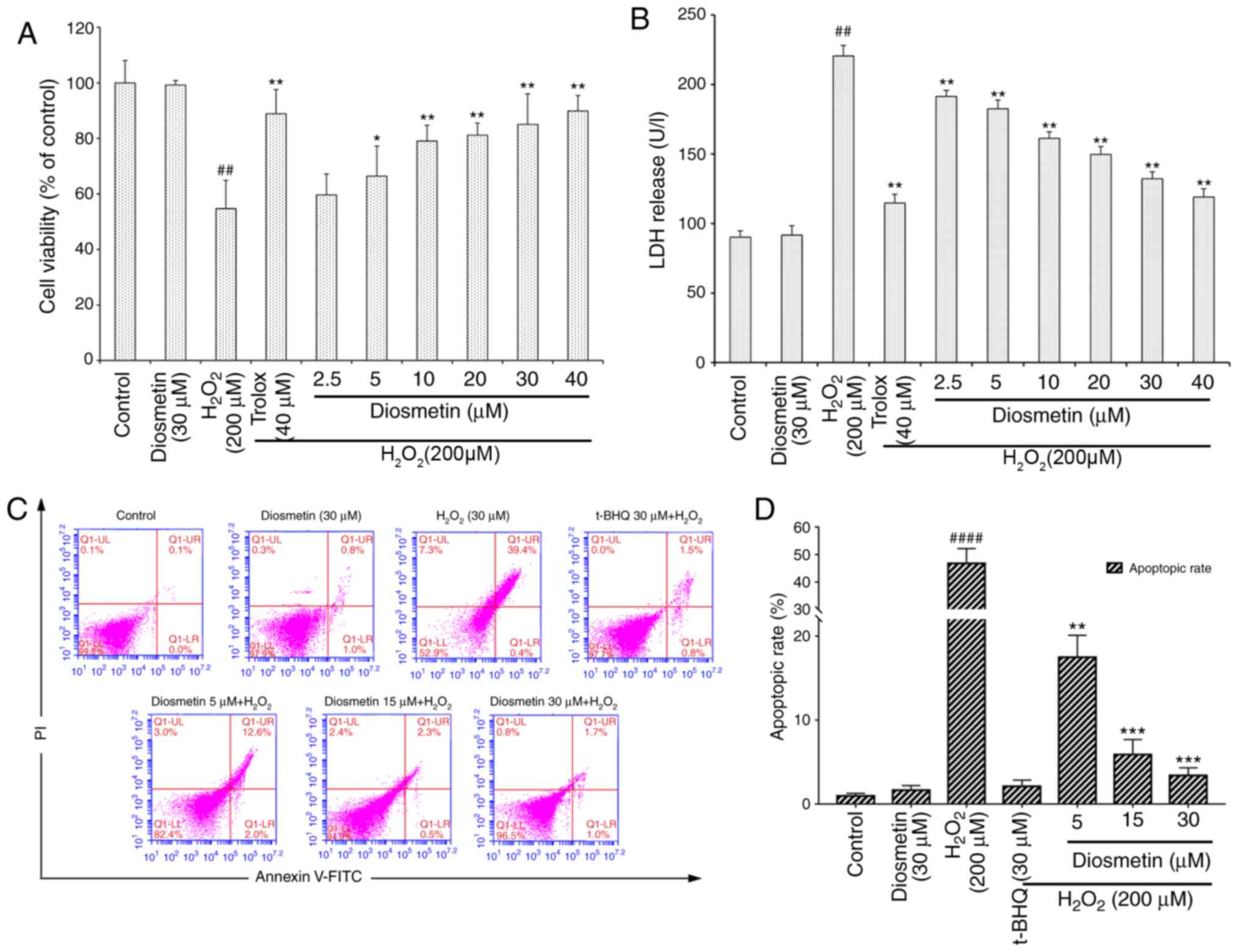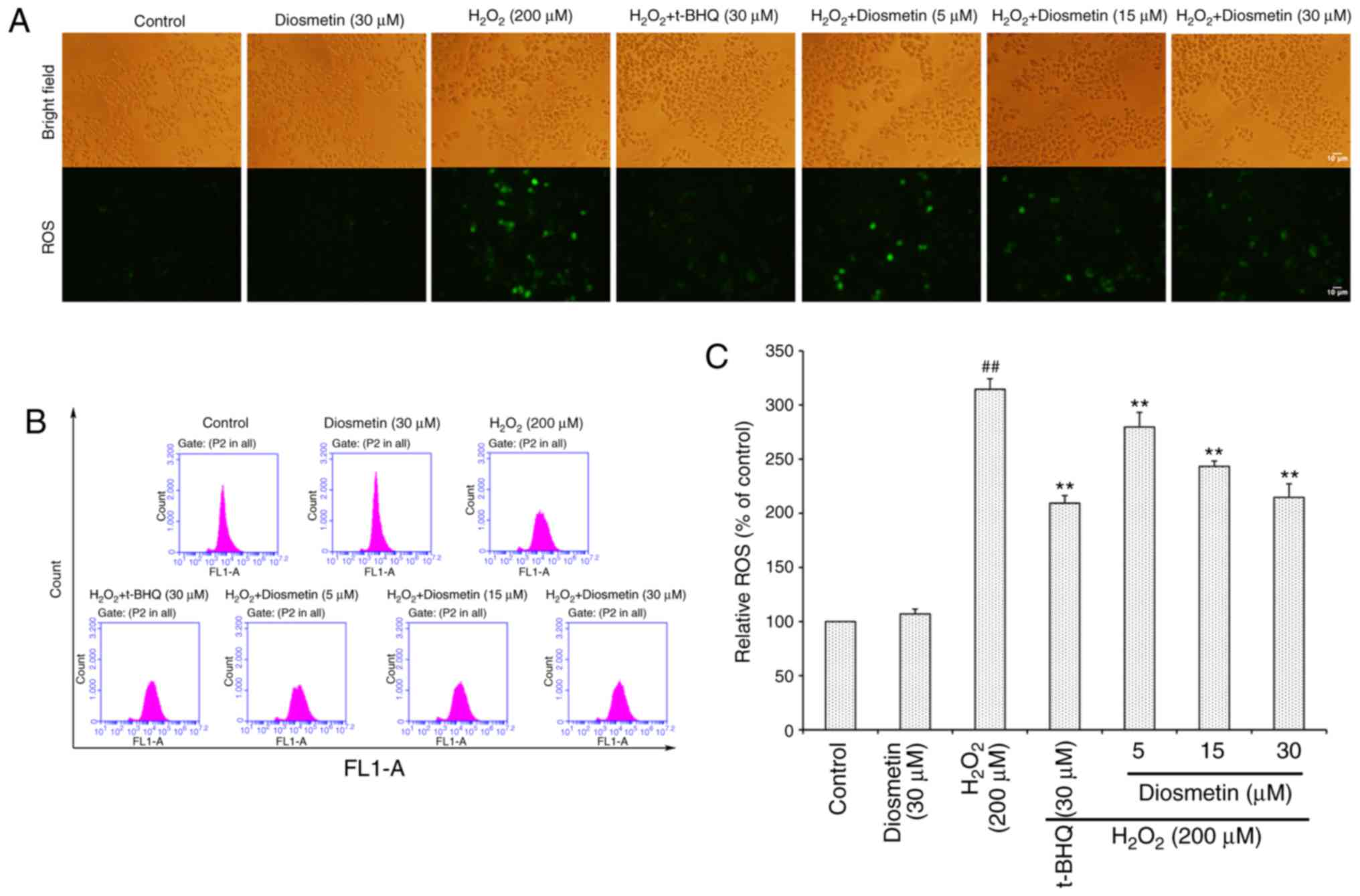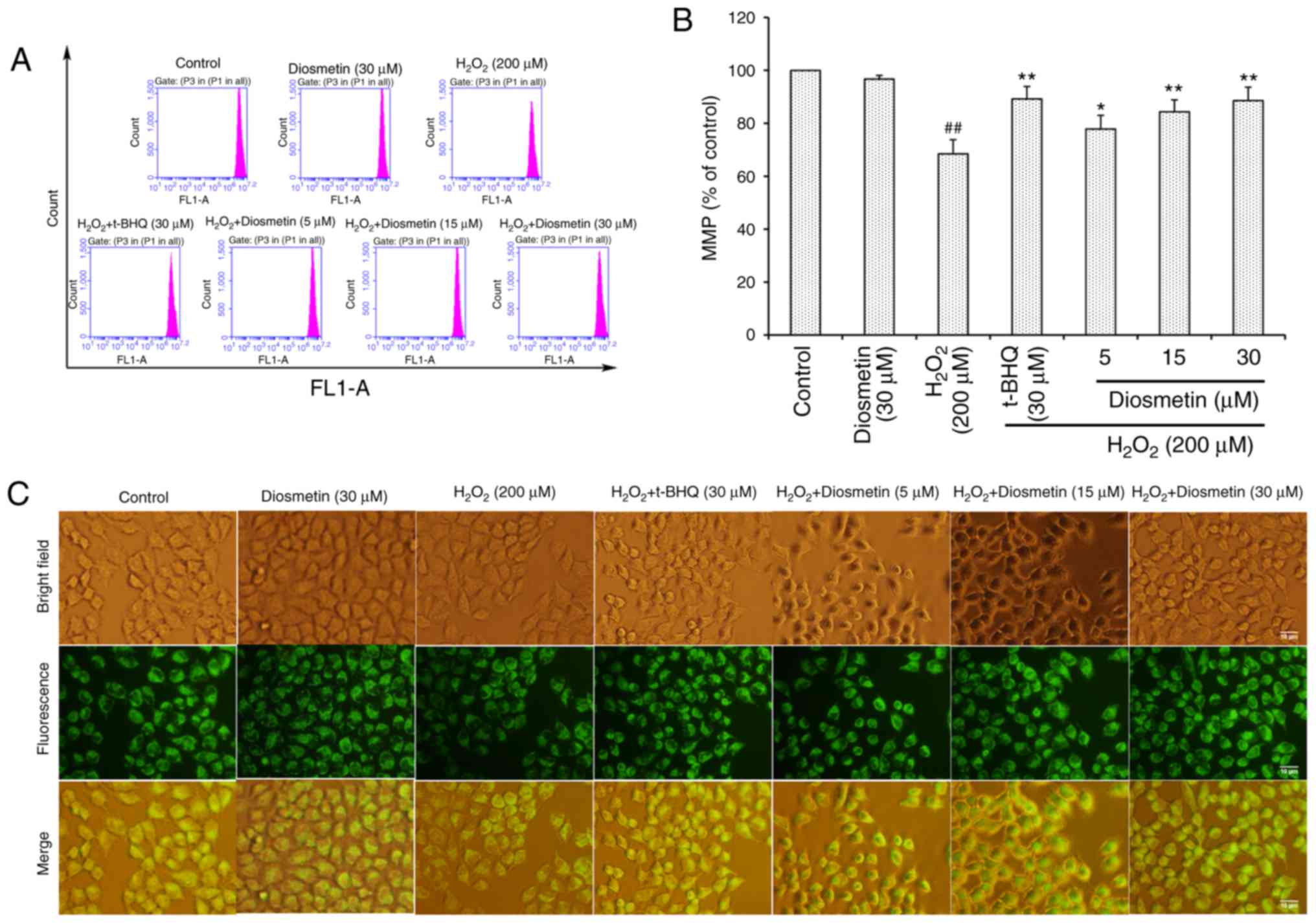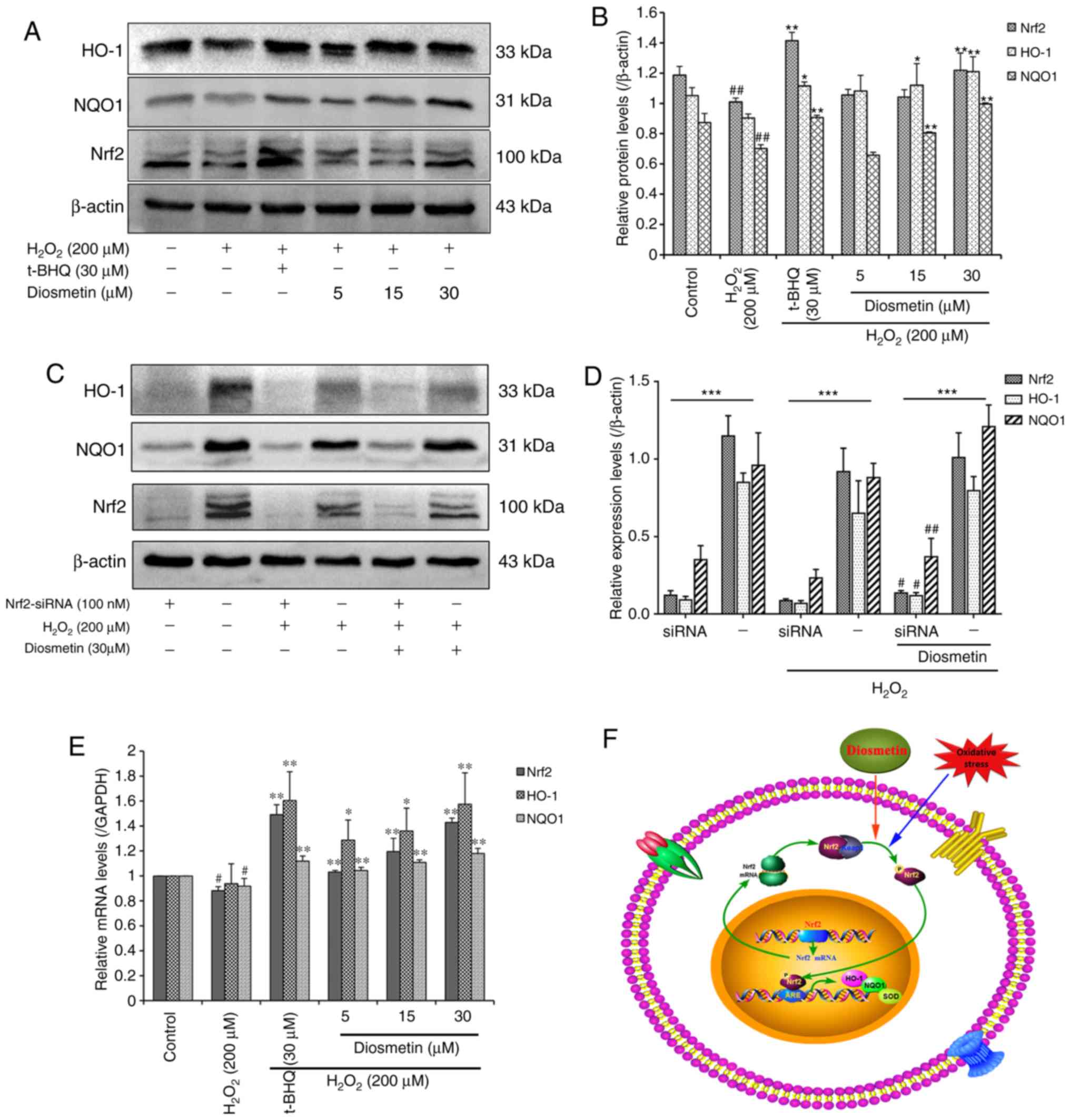|
1
|
Zhang H, Davies KJA and Forman HJ:
Oxidative stress response and Nrf2 signaling in aging. Free Radic
Biol Med. 88:314–336. 2015. View Article : Google Scholar : PubMed/NCBI
|
|
2
|
Webb C and Twedt D: Oxidative stress and
liver disease. Vet Clin North Am Small Anim Pract. 38(125–135):
v2008. View Article : Google Scholar
|
|
3
|
Zhang B, Dong JL, Chen YL, Liu Y, Huang
SS, Zhong XL, Cheng YH and Wang ZG: Nrf2 mediates the protective
effects of homocysteine by increasing the levels of GSH content in
HepG2 cells. Mol Med Rep. 16:597–602. 2017. View Article : Google Scholar : PubMed/NCBI
|
|
4
|
Espinosa-Diez C, Miguel V, Mennerich D,
Kietzmann T, Sánchez-Pérez P, Cadenas S and Lamas S: Antioxidant
responses and cellular adjustments to oxidative stress. Redox Biol.
6:183–197. 2015. View Article : Google Scholar : PubMed/NCBI
|
|
5
|
Hu Y, Wang S, Wang A, Lin L, Chen M and
Wang Y: Antioxidant and hepatoprotective effect of Penthorum
chinense Pursh extract against t-BHP-induced liver damage in L02
cells. Molecules. 20:6443–6453. 2015. View Article : Google Scholar : PubMed/NCBI
|
|
6
|
Leiser SF and Miller RA: Nrf2 signaling, a
mechanism for cellular stress resistance in long-lived mice. Mol
Cell Biol. 30:871–884. 2010. View Article : Google Scholar : PubMed/NCBI
|
|
7
|
Yan B, Ma Z, Shi S, Hu Y, Ma T, Rong G and
Yang J: Sulforaphane prevents bleomycin-induced pulmonary fibrosis
in mice by inhibiting oxidative stress via nuclear factor erythroid
2-related factor-2 activation. Mol Med Rep. 15:4005–4014. 2017.
View Article : Google Scholar : PubMed/NCBI
|
|
8
|
Han MH, Park C, Lee DS, Hong SH, Choi IW,
Kim GY, Choi SH, Shim JH, Chae JI, Yoo YH and Choi YH:
Cytoprotective effects of esculetin against oxidative stress are
associated with the upregulation of Nrf2-mediated NQO1 expression
via the activation of the ERK pathway. Int J Mol Med. 39:380–386.
2017. View Article : Google Scholar : PubMed/NCBI
|
|
9
|
Nguyen T, Nioi P and Pickett CB: The
Nrf2-antioxidant response element signaling pathway and its
activation by oxidative stress. J Biol Chem. 284:13291–13295. 2009.
View Article : Google Scholar : PubMed/NCBI
|
|
10
|
Tang W, Jiang YF, Ponnusamy M and Diallo
M: Role of Nrf2 in chronic liver disease. World J Gastroenterol.
20:13079–13087. 2014. View Article : Google Scholar : PubMed/NCBI
|
|
11
|
Garavito G, Rincón J, Arteaga L, Hata Y,
Bourdy G, Gimenez A, Pinzón R and Deharo E: Antimalarial activity
of some Colombian medicinal plants. J Ethnopharmacol. 107:460–462.
2006. View Article : Google Scholar : PubMed/NCBI
|
|
12
|
Meirinhos J, Silva BM, Valentão P, Seabra
RM, Pereira JA, Dias A, Andrade PB and Ferreres F: Analysis and
quantification of flavonoidic compounds from Portuguese olive (Olea
europaea L.) leaf cultivars. Nat Prod Res. 19:189–195. 2005.
View Article : Google Scholar : PubMed/NCBI
|
|
13
|
Patel K, Gadewar M, Tahilyani V and Patel
DK: A review on pharmacological and analytical aspects of
diosmetin: A concise report. Chin J Integr Med. 19:792–800. 2013.
View Article : Google Scholar : PubMed/NCBI
|
|
14
|
Liao W, Ning Z, Chen L, Wei Q, Yuan E,
Yang J and Ren J: Intracellular antioxidant detoxifying effects of
diosmetin on 2,2-azobis(2-amidinopropane) dihydrochloride
(AAPH)-induced oxidative stress through inhibition of reactive
oxygen species generation. J Agric Food Chem. 62:8648–8654. 2014.
View Article : Google Scholar : PubMed/NCBI
|
|
15
|
Bai N, Zhou Z, Zhu N, Zhang L, Quan Z, He
K, Zhang QY and Ho CH: Antioxidative flavonoids from the flower of
Inula Britannica. J Food Lipid. 12:141–149. 2005. View Article : Google Scholar
|
|
16
|
Meng JC, Zhu QX and Tan RX: New
antimicrobial mono- and sesquiterpenes from Soroseris hookeriana
subsp. erysimoides. Planta Med. 66:541–544. 2000. View Article : Google Scholar : PubMed/NCBI
|
|
17
|
Domínguez M, Avila JG, Nieto A and
Céspedes CL: Anti-inflammatory activity of Penstemon gentianoides
and Penstemon campanulatus. Pharm Biol. 49:118–124. 2011.
View Article : Google Scholar : PubMed/NCBI
|
|
18
|
Liu B, Shi Y, Peng W, Zhang Q, Liu J, Chen
N and Zhu R: Diosmetin induces apoptosis by upregulating p53 via
the TGF-β signal pathway in HepG2 hepatoma cells. Mol Med Rep.
14:159–164. 2016. View Article : Google Scholar : PubMed/NCBI
|
|
19
|
Androutsopoulos V, Wilsher N, Arroo RR and
Potter GA: Bioactivation of the phytoestrogen diosmetin by CYP1
cytochromes P450. Cancer Lett. 274:54–60. 2009. View Article : Google Scholar : PubMed/NCBI
|
|
20
|
Obmann A, Werner I, Presser A, Zehl M,
Swoboda Z, Purevsuren S, Narantuya S, Kletter C and Glasl S:
Flavonoid C- and O-glycosides from the Mongolian medicinal plant
Dianthus versicolor Fisch. Carbohydr Res. 346:1868–1875. 2011.
View Article : Google Scholar : PubMed/NCBI
|
|
21
|
Livak KJ and Schmittgen TD: Analysis of
relative gene expression data using real-time quantitative PCR and
the 2(-Delta Delta C(T)) method. Methods. 25:402–408. 2001.
View Article : Google Scholar : PubMed/NCBI
|
|
22
|
Marí M, Colell A, Morales A, von Montfort
C, Garcia-Ruiz C and Fernández-Checa JC: Redox control of liver
function in health and disease. Antioxid Redox Signal.
12:1295–1331. 2010. View Article : Google Scholar : PubMed/NCBI
|
|
23
|
Senthil Kumar KJ, Liao JW, Xiao JH, Gokila
Vani M and Wang SY: Hepatoprotective effect of lucidone against
alcohol-induced oxidative stress in human hepatic HepG2 cells
through the up-regulation of HO-1/Nrf-2 antioxidant genes. Toxicol
In Vitro. 26:700–708. 2012. View Article : Google Scholar : PubMed/NCBI
|
|
24
|
Ge A, Ma Y, Liu YN, Li YS, Guo H, Zhang
JX, Wang QX, Zeng XN and Huang M: Diosmetin prevents
TGF-beta1-induced epithelial-mesenchymal transition via ROS/MAPK
signaling pathways. Life Sci. 153:1–8. 2016. View Article : Google Scholar : PubMed/NCBI
|
|
25
|
Beal MF: Mitochondria take center stage in
aging and neurodegeneration. Ann Neurol. 58:495–505. 2005.
View Article : Google Scholar : PubMed/NCBI
|
|
26
|
Somayajulu M, Mccarthy S, Hung M, Sikorska
M, Borowy-Borowski H and Pandey S: Role of mitochondria in neuronal
cell death induced by oxidative stress; neuroprotection by Coenzyme
Q10. Neurobiol Dis. 18:618–627. 2005. View Article : Google Scholar : PubMed/NCBI
|
|
27
|
Dumont M and Beal MF: Neuroprotective
strategies involving ROS in Alzheimer disease. Free Radic Biol Med.
51:1014–1026. 2011. View Article : Google Scholar : PubMed/NCBI
|
|
28
|
Zorov DB, Filburn CR, Klotz LO, Zweier JL
and Sollott SJ: Reactive oxygen species (ROS)-induced ROS release:
A new phenomenon accompanying induction of the mitochondrial
permeability transition in cardiac myocytes. J Exp Med.
192:1001–1014. 2000. View Article : Google Scholar : PubMed/NCBI
|
|
29
|
Sies H: Role of metabolic H2O2 generation:
Redox signaling and oxidative stress. J Biol Chem. 289:8735–8741.
2014. View Article : Google Scholar : PubMed/NCBI
|
|
30
|
Li T, Chen B, Du M, Song J, Cheng X, Wang
X and Mao X: Casein glycomacropeptide hydrolysates exert
cytoprotective effect against cellular oxidative stress by
up-regulating HO-1 expression in HepG2 cells. Nutrients. 9:pii:
E31. 2017. View Article : Google Scholar
|
|
31
|
Huang Y, Li W, Su Z and Kong AN: The
complexity of the Nrf2 pathway: Beyond the antioxidant response. J
Nutr Biochem. 26:1401–1413. 2015. View Article : Google Scholar : PubMed/NCBI
|
|
32
|
Suzuki T and Yamamoto M: Molecular basis
of the Keap1-Nrf2 system. Free Radic Biol Med. 88:93–100. 2015.
View Article : Google Scholar : PubMed/NCBI
|
|
33
|
Ma Z, Li C, Qiao Y, Lu C, Li J, Song W,
Sun J, Zhai X, Niu J, Ren Q and Wen A: Safflower yellow B
suppresses HepG2 cell injury induced by oxidative stress through
the AKT/Nrf2 pathway. Int J Mol Med. 37:603–612. 2016. View Article : Google Scholar : PubMed/NCBI
|














